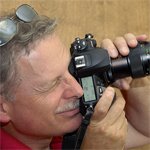As an early adopter of Gary Fong's Lightsphere flash modifier, I have touted its success to photogs looking for a better way to light at wedding and event assignments. In this blog, I include a sample image from a recent wedding that includes a simple but clear example of Nikon CLS lighting.

Deconstruct
Using the built-in flash as the Commander, you have a 33 foot communication range. An SB800 and SB600 were used on lightstands in Remote Mode and controlled at the camera through the Flash menu. Using the SB800 as a Commander permits control through its LCD interface - easier and quicker but you lose the use of a flash unit if it isn't well placed to light the picture. The built-in flash in this series was actually used to provide some fill at close range but I often turn off this flash and just use it to trigger the Remotes.
Each unit had a Lightsphere attached. I have modified mine with self-adhesive HVAC aluminum tape as shown here. This is to increase output when positioning the flash head straight on toward the subject where no reflective ceiling or wall is available.

Mounted on Bogen flash satnds, they were positioned in front of the group to the sides and close to the outermost individuals - with the Lightsphere/flash head assembly positioned straight up as Gary Fong recommends. This produces the least amount of shadow and maximum 'wrap' on the subjects. It worked in this instance because...
The Other Modifier
The ceiling was about 10-12 feet high - this is a major factor to consider in regard to light output - higher ceilings will force you to (1) angle the head toward the subjects for more illumination, or (2) raise the flash units up closer to your 'reflector' (ceiling) surface to reduce the length of the light path from the flash to the subject. In this image, they were placed a little over head height to cast shadows down and behind the group. As you angle the flash head more and more toward the subject, shadows will return as an issue to deal with - the Lightsphere only failing.

This pre-ceremony candid is a great example of 'wrap' lighting where walls aid the bounce effect of the Lightsphere.

Positioned straight up in close quarters, the Lightshere can use existing walls and ceiling to create a effective softbox effect, like here where we waited for the bride to emerge from a small room into the wedding hall.
Working Within Limits
Setting camera at ISO at 100 often pushes you to shoot near or at wide open with a slow f3.5 zoom - going to a 200 ISO adds a stop of DOF, so these units are working hard to expose well. I always set flash output by +3 in the camera's Flash menu for added available power.

Deconstruct
Using the built-in flash as the Commander, you have a 33 foot communication range. An SB800 and SB600 were used on lightstands in Remote Mode and controlled at the camera through the Flash menu. Using the SB800 as a Commander permits control through its LCD interface - easier and quicker but you lose the use of a flash unit if it isn't well placed to light the picture. The built-in flash in this series was actually used to provide some fill at close range but I often turn off this flash and just use it to trigger the Remotes.
Each unit had a Lightsphere attached. I have modified mine with self-adhesive HVAC aluminum tape as shown here. This is to increase output when positioning the flash head straight on toward the subject where no reflective ceiling or wall is available.

Mounted on Bogen flash satnds, they were positioned in front of the group to the sides and close to the outermost individuals - with the Lightsphere/flash head assembly positioned straight up as Gary Fong recommends. This produces the least amount of shadow and maximum 'wrap' on the subjects. It worked in this instance because...
The Other Modifier
The ceiling was about 10-12 feet high - this is a major factor to consider in regard to light output - higher ceilings will force you to (1) angle the head toward the subjects for more illumination, or (2) raise the flash units up closer to your 'reflector' (ceiling) surface to reduce the length of the light path from the flash to the subject. In this image, they were placed a little over head height to cast shadows down and behind the group. As you angle the flash head more and more toward the subject, shadows will return as an issue to deal with - the Lightsphere only failing.

This pre-ceremony candid is a great example of 'wrap' lighting where walls aid the bounce effect of the Lightsphere.

Positioned straight up in close quarters, the Lightshere can use existing walls and ceiling to create a effective softbox effect, like here where we waited for the bride to emerge from a small room into the wedding hall.
Working Within Limits
Setting camera at ISO at 100 often pushes you to shoot near or at wide open with a slow f3.5 zoom - going to a 200 ISO adds a stop of DOF, so these units are working hard to expose well. I always set flash output by +3 in the camera's Flash menu for added available power.



No comments:
Post a Comment